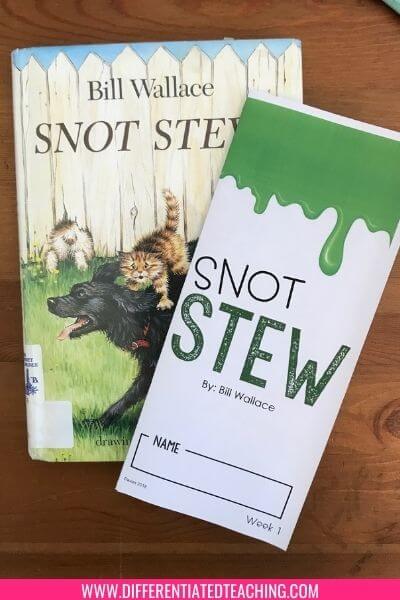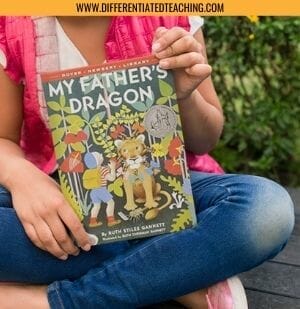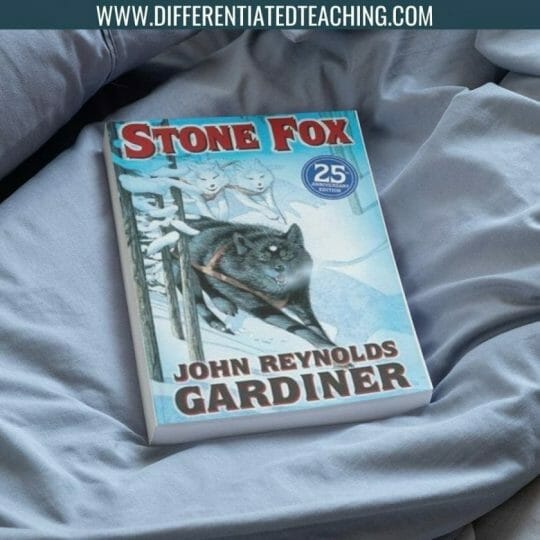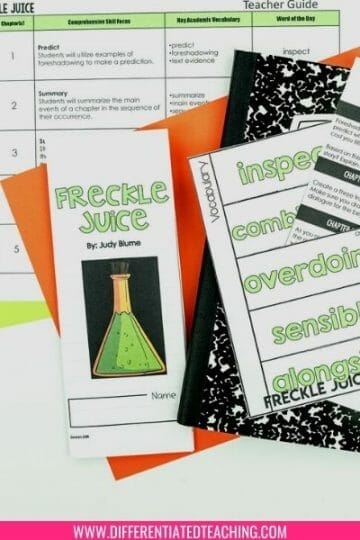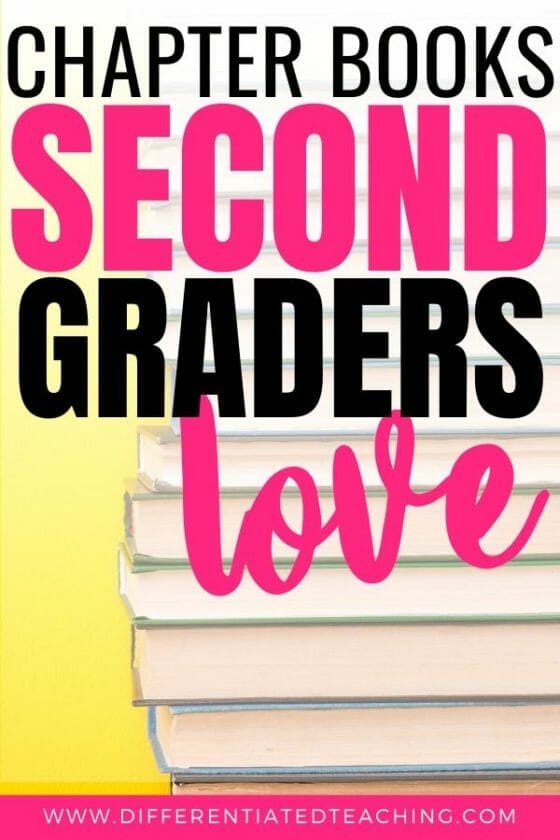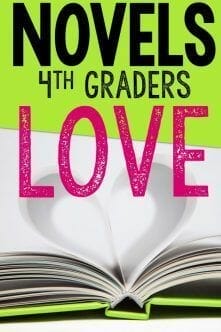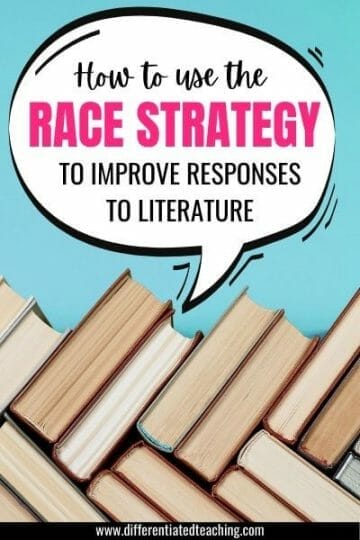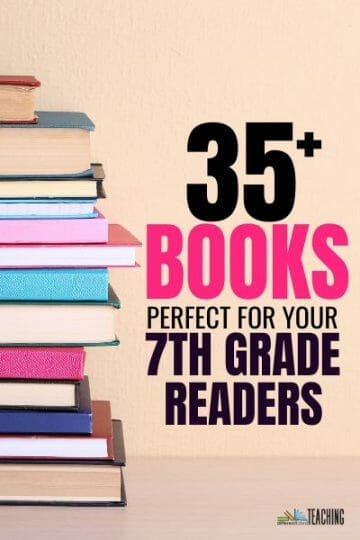The Best Chapter Books for 3rd Graders: Finding the Perfect Read
Third grade is such an exciting time for readers. Kids are ready to tackle books with a bit more depth, exploring stories with richer plots and more complex characters. But, as any teacher (or parent!) knows, finding that perfect book can be tricky.
It’s all about finding that sweet spot: Too easy, and they’re bored. Too complex, and they lose interest. If you’ve ever sifted through endless book lists, trying to pick the perfect read, you know exactly what I mean.
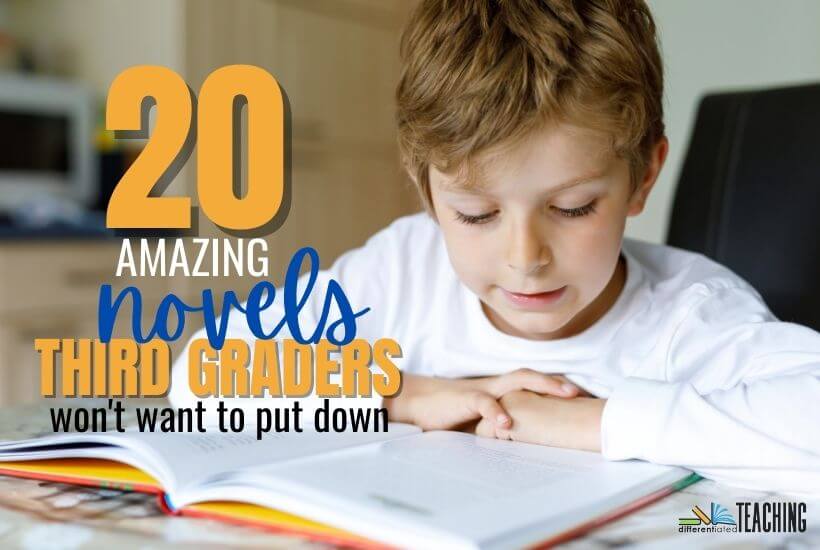
But don’t worry—I’ve got you covered! I’ve spent hours combing through recommendations, and with input from young readers themselves, I’ve curated a list of just-right books that will keep your 3rd grader excited to read and feeling confident.
My Favorite Novels & Chapter Books for 3rd Graders
Whether you’re building your classroom library or searching for a great book for your own kiddo, these novels are perfect for third-grade readers. I’ve included a summary of each book, plus links to helpful novel study resources to save you time. Your third graders are going to love these stories!
1. Third Grade Angels by Jerry Spinelli
A behavior award that everyone wants? Count me in.
In this charming story, George “Suds” is determined to be the first to win his teacher’s coveted behavior award. But he quickly learns that good behavior isn’t as simple as just being on your best behavior all the time. Suds’ journey through third grade will have your students laughing and reflecting on what it really means to be “good.”
Great for: Character development, cause and effect, and relatable school-life experiences.
Novel Study & Lesson Materials: Third Grade Angels Novel Study
2. How to Eat Fried Worms by Thomas Rockwell
This book is perfect for reluctant readers, especially the boys who enjoy humor with a side of gross-out fun. As Billy struggles to eat more than a dozen worms, he comes up with creative (and often funny) ways to make his task less disgusting.

I love how this story opens up chances to talk about cause and effect, problem-solving, and how characters evolve over time. Plus, it’s a quick, fun read that keeps kids hooked!
Great for: Humor, reluctant readers, and character change.
Learn more about the novel study: How to Eat Fried Worms Novel Study
3. Ramona Quimby, Age 8 by Beverly Cleary
If you’re looking for a book that your third graders will really connect with, Ramona Quimby, Age 8 is a must-have.
Ramona’s world is full of the same challenges your students face—balancing family life, navigating school drama, and dealing with peer pressure. It’s a fun, relatable story that’s perfect for text-to-self connections and comparing characters.
I can’t recommend it enough for your 3rd grade reading list—kids will love Ramona’s spunk, and you’ll love how easily it sparks important conversations.
Great for: Text-to-self connections, character comparisons, and real-world issues.
Novel Study & Lesson Materials: Ramona Quimby, Age 8 Novel Study
5. Fudge-a-mania by Judy Blume
Peter Hatcher’s summer plans are ruined when he has to spend time with his annoying “enemy,” Sheila. Things get more complicated when his parents let him bring his best friend—but he ends up spending more time with Sheila than anyone else.
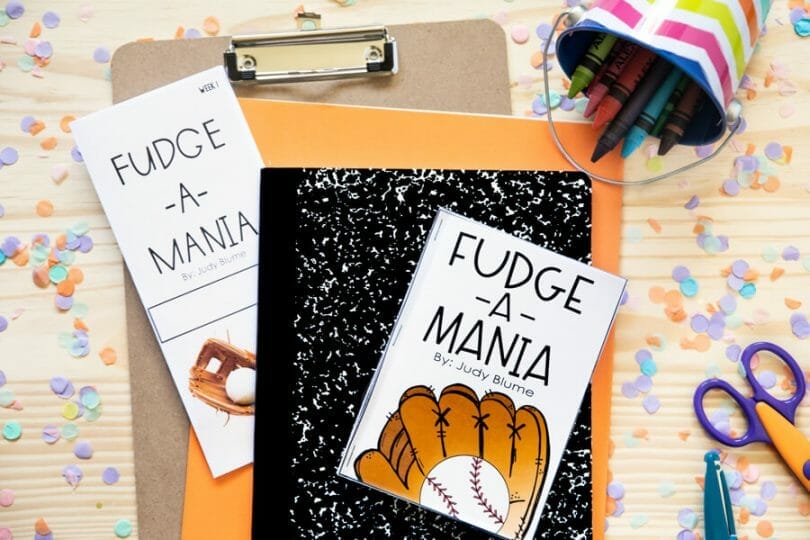
This book is perfect for 3rd-grade readers. The relatable family dynamics and humor keep kids engaged. It’s also a great way to teach protagonist vs. antagonist, showing that conflict isn’t always just “good guy vs. bad guy.”
Great for: Character dynamics, conflict, and predicting outcomes.
Novel Study & Lesson Materials: Fudge-a-mania Novel Study
6. Snot Stew by Bill Wallace
Don’t be fooled by the title—this isn’t a gross-out story, but it will surprise you in all the best ways.
Told from a cat’s perspective, Snot Stew is about two stray kittens finding their way at a new home after being adopted. They’re separated from their mom and must navigate their world in a way that only a cat could. The twists and changes in their relationship are so relatable, and you’ll be amazed at how the first-person narrative pulls you in.
What makes this book stand out? It’s perfect for teaching point of view, inferring, and understanding how text clues (like how a cat describes everyday household items) reveal deeper meaning. Kids will love figuring out what those clues are—plus, it’s a really fun, heartwarming read that I can’t recommend enough.
Great for: Point of view, inferring, and unique, heartwarming stories.
Novel Study & Lesson Materials: Snot Stew Novel Study
7. My Father’s Dragon by Ruth Styles Gannett
Elmer, a young boy, runs away to rescue a baby dragon, facing danger and excitement on Wild Island. Using only the items in his pack, Elmer outsmarts wild animals and takes readers on a wild, imaginative adventure.
With vibrant illustrations and clever problem-solving, this book is perfect for teaching character traits, sequencing, and how creativity can overcome obstacles. It’s a story that will stay with your readers long after they’ve finished.
Great for: Problem-solving, character development, and adventure lovers.
Novel Study & Lesson Materials: My Father’s Dragon Novel Study
8. The Littles by John Peterson
Imagine tiny people living in your house, using your things without you even knowing! That’s the premise of The Littles, a fun fantasy novel that’s perfect for young readers. Plus, it’s the start of a whole series that kids will love.
Great for: Problem-solving, critical comprehension skills, and fans of quirky adventures.
9. Flora & Ulysses by Kate DiCamillo
No list of great books would be complete without a graphic novel, and Flora & Ulysses is the perfect choice for your 3rd graders.
Written by award-winning author Kate DiCamillo, this fun story follows a superhero squirrel and the girl who saves him on their zany adventures. It’s a silly, exciting read that’s perfect for reluctant readers and a great introduction to DiCamillo’s work.
Great for: Graphic novel lovers, reluctant readers, and quirky adventures.
Novel Study & Lesson Materials: Flora & Ulysses Novel Study
10. The Chocolate Touch by Patrick Skene Catling
Imagine everything you touch turning to chocolate… sounds awesome, right? That’s what John Midas thought, too, until things started going terribly wrong.
This fun twist on the Midas myth is a hit with readers, even reluctant ones. John’s journey from excitement to frustration with his “gift” is one kids can really connect with.
The Chocolate Touch is a well-loved classic that’ll keep your students hooked. I promise they’ll be begging for more reading time!
Great for: Cause and effect, predictions, and engaging reluctant readers.
Novel Study & Lesson Materials: The Chocolate Touch Novel Study
10. Sideways Stories from Wayside School by Louis Sachar
Looking for a book that will have your students laughing out loud? Sideways Stories from Wayside School is just what you need.
This collection of quirky short stories takes place in a wacky school where the rules don’t quite make sense. From a teacher who turns her students into apples to a boy who gets sent home early for being a good friend, the strange and silly situations will keep kids entertained from start to finish.
Each story is its own little adventure, so it’s also perfect for a beginning of year read-aloud or independent reading. Personally, I’ve always loved kicking off the school year with this one—it’s an instant hit that gets everyone giggling and hooked on reading!
Great for: Humor, quirky characters, and classroom fun.
Novel Study & Lesson Materials: Sideways Stories from Wayside School Novel Study
11. Magic Tree House: Dinosaurs Before Dark by Mary Pope Osborne
The Magic Tree House series is one of my all-time favorites! It’s perfect for 3rd graders—whether you’re reading aloud or they’re tackling it on their own.
In this first book, Jack and Annie travel back to the time of dinosaurs on a mysterious quest. Not only is the story exciting, but kids also learn fun facts about dinosaurs as Jack does his research.
This series is great for teaching facts vs. opinions and other important reading skills. It’s a wonderful way to get your students hooked on reading!
Great for: Introducing adventure genre, learning facts, and developing reading skills.
Novel Study & Lesson Materials: Dinosaurs Before Dark Novel Study
12. The Best School Year Ever by Barbara Robinson
If you’re looking for a laugh-out-loud read for your students, The Best School Year Ever is a perfect pick!
It’s the second book in the Herdman series, and let me tell you, the Herdman kids are the ultimate troublemakers. The narrator, a classmate of one of the Herdmans, shares all the wild rumors and chaos that follows them. But here’s the twist—by the end of the year, the class starts to see that maybe, just maybe, the Herdmans aren’t as bad as everyone thought.
This book is perfect for discussions on finding the good in others, and the humor will have your students cracking up the whole way through.
Great for: Humor, character development, and finding the good in others.
Get The Best School Year Ever Novel Guide
13. The Indian in the Cupboard by Lynne Reid Banks
What kid hasn’t dreamed of their toys coming to life? That’s exactly what happens in The Indian in the Cupboard, and it’s one of the reasons this fantasy is such a hit with 3rd graders!
When Omri gets a cupboard for his birthday, he decides to lock his plastic Indian toy inside. But to his shock, the toy comes to life! His new friend, Little Bear, is a living, breathing man, and Omri quickly becomes responsible for his care. But when a cowboy named Boone arrives, things get complicated. Will they ever get along?
This book is perfect for comparing and contrasting characters, and it’s a great way to practice visualizing with your students. Plus, the excitement will have them hooked from the very first chapter.
Great for: Comparing and contrasting, visualizing, and magical adventures.
Novel Study & Lesson Materials: Indian in the Cupboard Novel Study
14. Stuart Little by E.B. White
If your students have seen the movie, Stuart Little is the perfect way to dive into the book!
Stuart is a mouse born into a human family, living in the bustling world of New York City. His adventures around Manhattan are full of surprises and challenges—after all, being small in a big city isn’t easy! The familiar plot makes it a great choice for helping students strengthen comprehension skills.
This classic is also perfect for vocabulary, context clues, and comparing the book to the movie, giving students a chance to make real-world connections.
Great for: Comprehension, vocabulary, and making connections between text and media.
Novel Study & Lesson Materials: Stuart Little Novel Study
15. Stone Fox by John Reynolds Gardiner
First, a little disclaimer—keep tissues handy, because this one will likely bring tears. It’s one of the saddest books on this list, but also one of the most powerful.
Stone Fox tells the story of Little Willy and his loyal dog, Searchlight, as they race to save his grandfather’s farm. Willy is an incredibly likable character, and your students will be rooting for him every step of the way.
This book is a must-read for third graders, and it makes a perfect winter read-aloud or book study. I’ve read it so many times with my students, and it still gets me every time—Gardiner’s writing is that compelling.
If you’re planning a unit on the Iditarod or want to make connections to math and social studies, Stone Fox is a great fit.
Great for: Character development, emotion-driven storytelling, and cross-curricular connections.
Learn more about some engaging STEM challenges you can pair with this novel.
16. Boxcar Children by Gertrude Chandler Warner
This classic book is one I’ve always loved, and I’m excited to share it with my students. The Boxcar Children tells the story of four orphaned siblings—Henry, Jessie, Violet, and Benny—who create a home for themselves in an abandoned boxcar in the woods.
The kids do everything on their own—cooking, cleaning, and earning money—while avoiding being found by their grandfather, whom they’ve never met. Their adventure is full of surprises, and this first book in the series is perfect for hooking reluctant readers with an easy-to-read, engaging series.
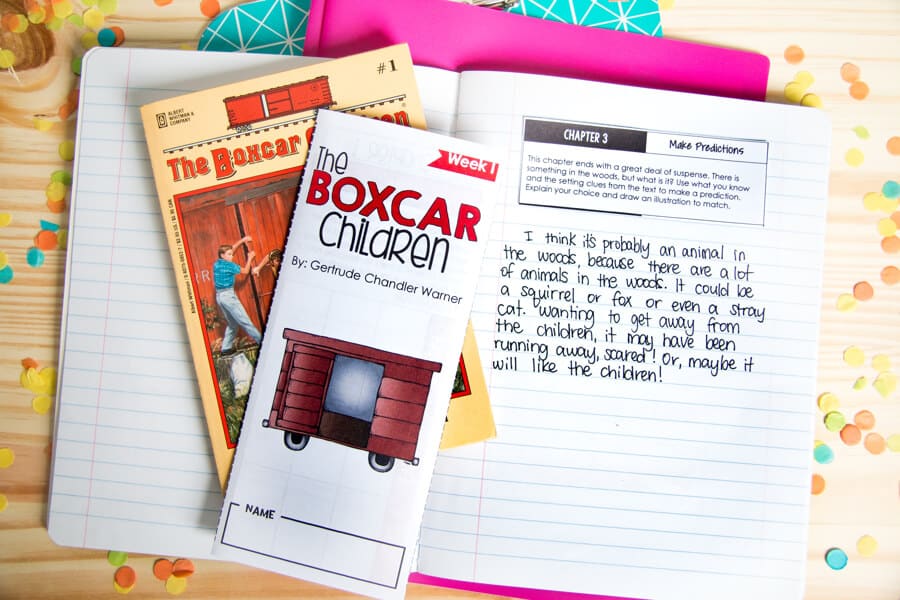
It’s a must-have in your 3rd grade classroom library, especially with its great vocabulary and timeless appeal.
Great for: Adventure, character development, and vocabulary building.
Novel Study & Lesson Materials: The Boxcar Children Novel Study
17. Little House in the Big Woods by Laura Ingalls Wilder
This story was written by Laura Ingalls Wilder and is the semi-true adventure of her family’s move to Wisconsin when she was a young girl. Throughout the story, Laura describes her work to help her Ma and Pa and how the family always finds time to play together.
From butchering their meat to gathering wood for the fire, the Ingalls must do everything they need to survive. As the book works through each season, the family’s work changes. Planting, making butter, and more.
Students are often fascinated by life long before there were grocery stores everywhere. Great for comparing the past and present, a commonly studied social studies unit, this story details life during the 1800s. This is the first of four books in the Little House series.
Novel Study & Lesson Materials: Little House in the Big Woods Novel Study
18. Geronimo Stilton #1: Lost Treasure of the Emerald Eye
If you’re looking for something fast-paced and fun, the Geronimo Stilton series is perfect. While these books aren’t as text-heavy as some others, they’re packed with adventure, humor, and fascinating facts.
In the first book, Geronimo embarks on a quest to solve the mystery of a missing treasure. With plenty of twists and turns and tons of visuals, it’s a great choice for reluctant readers or anyone looking for an easy, engaging read.
This is just the start—if your students enjoy this one, there’s a whole series waiting for them!
Great for: Adventure, reluctant readers, and fast-paced stories.
19. Freckle Juice by Judy Blume
Freckle Juice is one of those hilarious gems that your third graders will love. Andrew is desperate to have freckles like his classmate, thinking it will solve all his problems—like avoiding his mom’s neck-washing reminders. When a classmate offers him a recipe for “freckle juice” at just 50 cents, things take a hilarious turn.
This story is relatable, funny, and perfect for teaching theme and problem & solution. It’s a great choice for getting your students hooked on reading and discussing the challenges of wanting to be someone else.
Great for: Theme, problem-solving, and relatable humor.
20. Mrs. Piggle-Wiggle by Betty MacDonald
The book is a collection of short stories about the title character, an eccentric woman who knows how to deal with children’s bad habits. From kids who won’t take baths to those who are always losing their temper, Mrs. Piggle Wiggle has a cure for everything.
Your students will love hearing about the wild antics that take place in each story, and you can use the book as a springboard for discussing character traits, problem-solving, and more.
If you’re looking for a feel-good read, Mrs. Piggle Wiggle is a good choice!
21. Bunnicula by Deborah & James Howe
Told from the perspective of the family dog, Harold, Bunnicula is the story of what happened after the family found a baby rabbit at the movie theater during a screening of Dracula.
When Chester (the family’s cat) notices something strange about the new addition, he decides the rabbit must be a vampire and tries to alert the Monroe family.
Another really funny book, this novel is great for Halloween or any time. The narrator’s engaging storyline and unique perspective make it a perfect book for students who are into vampires and other supernatural happenings.
The text offers a number of great opportunities to infer and draw conclusions, which is a challenging skill for many 3rd graders.
Learn more about this and other great spooky stories here.
22. Esio Trot by Roald Dahl
A love story with a twist, this is the story of Mr. Hoppy and his plans to win the adoration of Ms. Silver via her beloved tortoise (Alfie). After telling Mr. Hoppy she wished she knew how to help Alfie grow larger, he concocts a wacky plan to win her over. Your students will love discussing this hare-brained plot and predicting whether it will work. (Spoiler: It does!)
With vivid description and silliness that only Dahl can bring to a children’s novel, this story is overall an easy read and fan favorite among books for 3rd graders. There are many great opportunities to discuss character traits and practice visualization, inferring, and more.
While the text has some made-up words (as do nearly all Dahl’s books), the plotline draws readers in and encourages them to overcome these challenges because the story is just that good.
Novel Study & Lesson Materials: Esio Trot Novel Study
23. The Wild Robot by Peter Brown
Your animal-loving students with The Wild Robot!
After a shipwreck, Roz the robot washes ashore on an uninhabited island. At first, she is only concerned with her survival, but as time passes, she starts to feel lonely. When a family of creatures finds her, Roz begins to learn about companionship with your animal-loving students with The Wild Robot!
A former Global Read Aloud book, The Wild Robot is a good book to discuss character traits, emotions, and more with your third-grade class.
Don’t forget to check out the corresponding lesson plans and materials for the book!
Novel Study & Lesson Materials: The Wild Robot Novel Study
Find the perfect novel for your third graders to enjoy!
While it can be challenging to find quality novels with engaging plots that support deep conversation and critical thinking about text that will appeal to a broad range of readers, I hope that this list will help guide you in the right direction. All twenty books on this comprehensive list are quality literature that your 3rd graders will love, whether you decide to use them as a read-aloud or incorporate them as you plan your next novel unit.
I hope this list has sparked some ideas for adding books to your classroom library and your next novel unit. While you’re here, grab my free novel study planning roadmap to get step-by-step support to plan a high-quality literature unit for your third-grade students, whether you’re in the classroom or homeschooling.

